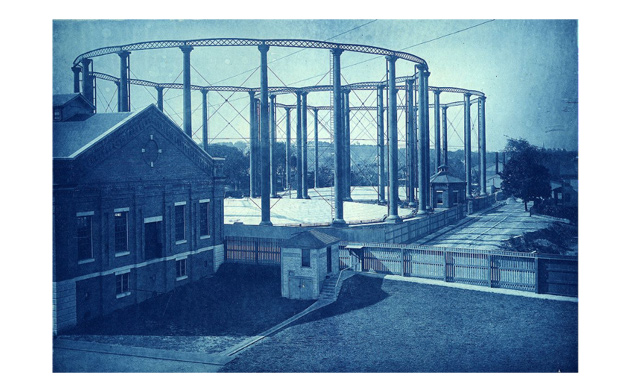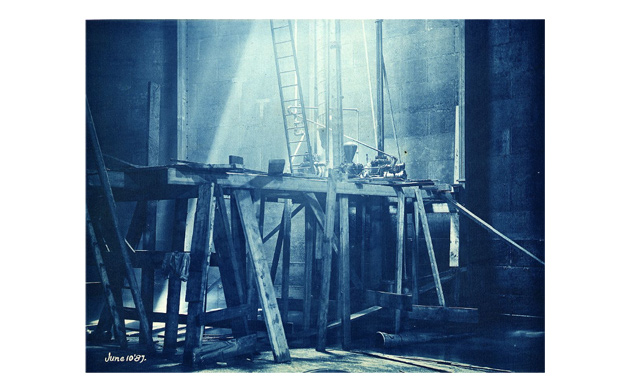When two tanks greeted motorists on the Expressway

In 1984, Lou Jones took an aerial photo of the two Boston Gas tanks on Commercial Point off the Expressway and Morrissey Boulevard in Dorchester.
Boston Gas built the two tanks in 1971 - after paying Corita to paint one of them with her rainbow swash/Ho Chi Minh memorial. The company removed the Corita tank in 1992, but took care to reproduce the mural - the world's largest copyrighted artwork - on the remaining tank.
The two solid tanks replaced an even larger "gasholder" on the site - roughly six times as large as one of the new tanks. That holder, a holdover from the days when Boston was dotted with similar structures to store naphtha gas and gas generated from coal, was sort of a giant balloon inside a steel lattice - as gas was pumped in, the cover would rise into the sky, then slowly deflate as gas was pumped out.
In the 1880s, the Boston Gas Light Company built two gasholders on the site:

The pump at the bottom of one of the tanks:

Both photos from the Boston Gas Company Records held by Boston College.
Going even further back, Commercial Point was once, somewhat briefly, a residential area that included a pair of palatial homes. As the Dorchester Historical Society notes:
Soon after 1800 Joseph Newell and Ebenezer Niles, who thought Commercial Point would prosper in whale and cod fishing, built neighboring large, square, palatial houses on the south side of the point looking south toward Port Norfolk. They connected themselves as partners in business, built vessels and were actively engaged in commercial matters, but the panic resulting from the War of 1812 put a close to their business speculations and prospects.
Later, others would try to follow in Newell's and Niles's whaling footsteps on Commercial Point. In the 1830s:
A syndicate was formed for the prosecution of the whale and cod fisheries at Commercial Point. This syndicate was composed of Messrs. Nathaniel Thayer, a brother of John E. Thayer, the founder of the house of the well-known firm of Kidder, Peabody, & Co.; Mr. Elisha Preston, of Dorchester, who was the senior part of the firm of Preston & Thayer; Mr. Josiah Stickney, a well-known Boston merchant; and Mr. Charles O. Whitmore, of the firm of Lombard & Whitmore, whose residence was near the Point, and who acted as "ship's-husband" for the vessels composing the fleet. Their goal was to whale in the Pacific, Indian, and North Atlantic oceans. The ships bought by the company were the "Charles Carroll," of Nantucket; "Courier," "Herald," and bark "Lewis," plus they equipped twenty schooners, of which two - the "Belle" and "the Preston" - were built at the Point. They purchased not only the wharf, but quite a tract of land in its immediate vicinity, where they put flakes for the drying of their codfish. They also built some cooper-shops and a store for the supply of sailors' outfits and ship chandlery. The store was built from the material that came from the granary building which formerly occupied the site of the present Park Street Church in the city proper."
In the 1850s, one merchant began storing wood and coal on the point. And then:
In 1872 Dexter Josiah Cutter started a heating fuel company at Commercial Point, bringing in wood and coal on boats. The 1874 atlas shows that the Boston Gas Light Company occupied the outer portion of the Point, and John Preston had a chocolate factory and wharf at the southeastern corner. In the 1880s the Boston Gas Light Company owned nearly all of the Point and added two gas holders (coal gas tanks) along with coal shed, retort house, purifying house, condensing house, machine shop and other buildings. D.J. Cutter maintained its coal yard at this located location through at least the 1930s. Later they became a heating fuel delivery company located farther north on Freeport Street.
Top, cropped photo copyright Lou Jones. Used under this Creative Commons license.
Ad:

Comments
Lou Jones
https://www.fotojones.com/
Gasholder history…
I’m not quite old enough to have seen the Boston gasholders, but I remember seeing at least one of them along the highway in Providence, but I’m not sure if it’s there anymore, either. A web search suggests that Providence had one, but that one, Atlantic Mills, doesn’t look anything like what I remember — the photos show a solid brick structure, where the one I remember was more of a lacy steel girder lattice, something like this, except that particular one is/was in King’s Cross, London, not Rhode Island.
Amusingly, this sent me down a Wikipedia rabbit hole, where of course the Gasholder house article turned up. And that article currently cites exactly one “Further Reading” authority:
Heh. :-)
We called it "The Roundhouse"
We called it "The Roundhouse" when I was a kid. No one had any idea why it was there back then. I always though it had something to do with Dutch Boy Paints which had a prominent mural billboard painted on it back then.
Makes sense now. That thing probably serviced all the hospitals, houses, projects, churches, the Green Shoe factory and other businesses in the area. There used to be a lot of houses on Albany Street back then too.
Regular and Unleaded.
Regular and Unleaded.
A couple of other views of the old tank
I do remember the old tank next to the Expressway. Here are a couple of pictures from the 60s. It was expandable (non technical term) so you could see the tank go up and down depending on how much gas was stored.
https://www.facebook.com/DotHistorical/photos/a.107416320895/10157078924...
https://www.pinterest.com/pin/the-original-boston-gas-tank-circa-the-ear...
Two tanks
My friend from Puerto Rico called the tanks "las dos tetas de Boston"
National Grid narrative leaves out the leak
The original rainbow tank sprung a leak in valve system which could have taken out Savin Hill, Port Norfolk and Squantum. The risk is a rapid vaporization event not gas ignition. They quietly transferred the LNG out and deconstructed the tank and no one asked any questions. Of course they recreated Ho Chi Minh to watch over the memorial to the dead Dorchester boys on Morrissey, and haunt the ARVN vets who pass by every day.
Enjoyed this article, thanks!
Enjoyed this article, thanks!
As mentioned in the WGBH story linked to, Corita Kent designed the work and BostonGas contracted with a painting company to paint the design onto the tank. This was a Weymouth company owned and operated by Clarence Okerfelt, who my parents knew.
Interesting how this very public artwork with its representation of the profile of Ho Chi Minh went up in 1972 and stayed up. I’m sure some people objected to it then and maybe still don't like it, but it’s still right there.
Never was Ho.
The artist stated that this was never an image of Ho. Rather it was intended to mimic a "drizzle" of paint as if the color was splashed there. The image of Ho was invented by passers by and that rapidly caught on. Within a short period it was a controversy and the fake news spread wildly. This was well covered in the press. No changes were made because it was a misinterpretation of the artwork.
Nope
It is 100% Ho Chi Mihn.
Thanks for trying to obfuscate the obvious. I have been looking at it my entire life. It was Sr. Corita's little joke.
Of course, the irony of this fossil fuel monster is that it has been adopted as a symbol of Dorchester, primary by the DotOut and DBC crowd. These aren't typically people who support a massive greenhouse gas operation in their neighborhood.
Additional nope
Ho's image on the tank is pure urban legend. If anyone has any data or proof that it's Ho, then let's hear it.
Corita was against the war like many of us, but there is no evidence of any kind that she was pro Ho or pro Viet Cong or pro communist. (I also was against the war but was not pro Ho or pro Viet Cong or pro communist).
It's a long time urban legend based on speculation and opinions. There has been a Vietnamese community in Dorchester since the late 70s/early 80s. I know some Vietnamese individuals in Dorchester. They don't like Ho Chi Minh, they don't like communism, and in many cases don't like anyone from North Vietnam. I have never seen or heard any indication that any of them believe this urban legend.
Ho Chi Minh victorious on US soil
They probably don't like Ho Chi Minh because they collaborated with the United States and had to flee when the US lost the war. Similar to Cuban exiles who fled after the US puppet dictator Bautista was overthrown.
You don't have to be a communist to support anti-imperialists. The US invaded Vietnam and they forced the US to retreat, fair and square, just like the US forced out the British.
It's like saying "I oppose the Death Star but I don't support Luke Skywalker and the rebellion"
Poor Dot rats. Just don't
Poor Dot rats. Just don't feel complete without someone to hate or look down on.
Things that are not true
Boston Gas was pro communist
Keyspan was pro communist
National Grid is pro communist
Corita Kent, a Catholic nun, was pro communist
The anti war movement in the 60s and 70s was pro communist
Anyone who is not a republican is pro communist
Ho Chi Minh's image is on the gas tank
And Fidel Castro's image
was never on that other tank.
It was Billy Bulger's.
What a sight
As a child driving by those tanks I thought those things were incredibly huge and I always wanted to go inside.